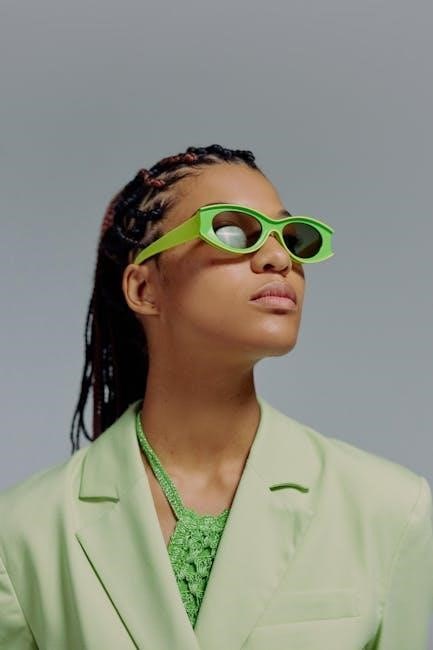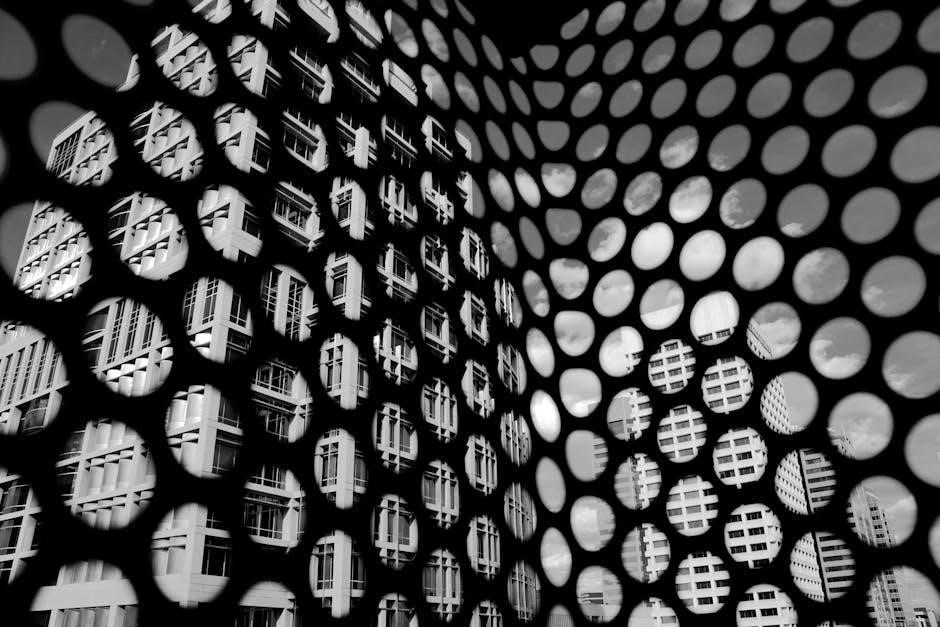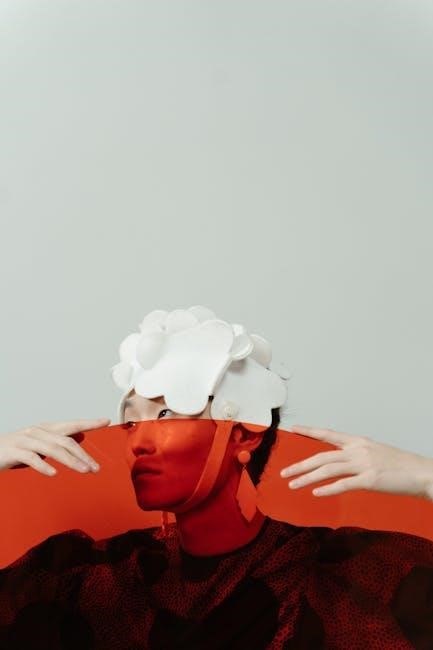
High contrast images are essential for newborns, as they stimulate visual development and cognitive growth. Simple black-and-white patterns help babies focus and explore their surroundings effectively.
1.1 What Are High Contrast Images?
High contrast images are visual tools that use sharp differences in color, typically black, white, and gray tones, to capture infants’ attention and aid visual development. These images are simple, without complex details, making them easier for newborns to focus on. They play a crucial role in stimulating babies’ vision and supporting their cognitive growth, helping them explore their environment effectively from an early age.
1.2 Importance of Visual Stimulation in Early Development
Visual stimulation is crucial for infants’ early development, aiding in cognitive and sensory growth. High contrast images help babies understand their environment, as their color vision develops slowly. These images enhance focus and curiosity, fostering brain development and visual acuity. Simple, bold patterns are particularly effective, engaging young minds and encouraging exploration. This early exposure lays the foundation for stronger visual skills and overall developmental progress in the first few months of life.
Benefits of High Contrast Images for Baby Development
High contrast images aid visual and cognitive growth, helping babies focus and enhancing sensory skills. They support early development and keep little ones engaged naturally.
2.1 Enhancing Visual Stimulation and Focus
High contrast images, especially black and white, are vital for newborns as they enhance visual stimulation and focus. These images are easier for babies to see, encouraging engagement and brain development. The sharp contrast helps babies differentiate between objects and stimulates the visual cortex, fostering better focus and tracking abilities. Regular exposure to such images supports early visual milestones and prepares the foundation for advanced cognitive and sensory development.
2.2 Improving Cognitive Development
High contrast images play a significant role in improving cognitive development by stimulating a baby’s brain activity. These images help babies recognize patterns, shapes, and objects, enhancing problem-solving skills and memory. The clarity of black and white contrasts aids in developing attention span and understanding visual relationships. This early exposure lays a strong foundation for future learning, fostering curiosity and engaging the baby’s developing mind in meaningful ways.
2.3 Supporting Sensory Development
High contrast images significantly support sensory development by stimulating a baby’s visual pathways. These images encourage exploration and engagement with the environment, fostering curiosity and sensitivity to visual cues. The stark differences in color and shape help babies develop their ability to process and interpret sensory information, which is crucial for overall growth and interaction with the world around them.

Science Behind High Contrast Images
The science behind high contrast images reveals their role in enhancing visual pathways and stimulating brain activity, crucial for early sensory and cognitive growth in infants.
3.1 How Babies See the World
Newborns have limited vision, focusing best on high-contrast patterns due to immature visual systems. They see the world in shades of gray with low detail, making black-and-white images ideal for early visual engagement. As babies grow, their ability to detect colors and finer details improves, but high-contrast visuals remain crucial for capturing their attention and aiding developmental milestones. This understanding helps create effective visual aids tailored to their unique visual capabilities at each stage.
3.2 Role of Black and White in Visual Development
Babies are born with limited color vision, seeing the world in shades of gray. High-contrast black-and-white images provide the clarity needed for newborns to focus and engage. These visuals stimulate visual pathways, aiding in the development of object recognition and depth perception. As babies grow, their ability to distinguish colors improves, but black-and-white patterns remain effective for capturing attention and promoting visual maturity. This simplicity ensures optimal engagement during critical early developmental stages.
3.3 Research Supporting High Contrast Image Use
Studies confirm that high-contrast images significantly benefit infant visual development. Research shows newborns prefer simple, high-contrast patterns, which enhance focus and stimulate visual pathways. These images aid in object recognition and depth perception development. Experts emphasize that black-and-white visuals are more effective than color for early stimulation. Studies using head-mounted cameras reveal that infants experience high-contrast environments naturally, supporting the idea that such images align with their visual preferences and developmental needs.
How to Create High Contrast Images for Babies

Design simple, bold patterns using black and white. Avoid clutter, ensuring clear visual focus. Use high-quality paper for printing, and ensure images are large enough for easy viewing.
4.1 Design Principles for Effective Contrast
Effective high-contrast images rely on simplicity and clarity. Use bold black-and-white patterns or shapes against plain backgrounds. Avoid overly detailed designs, as these can overwhelm a baby’s developing vision. Ensure that the contrast is sharp, with no middle tones or colors, to make images stand out. Simple geometric shapes and lines work best, as they provide clear visual stimulation without complexity. This approach helps babies focus and engage with their surroundings more effectively.

4.2 Tools and Software for Making High Contrast Images
Creating high-contrast images for babies is easy with the right tools. Use graphic design software like Canva or Adobe Illustrator for precise control over colors and patterns. For simpler designs, apps like Photoshop Express or GIMP are great options. Additionally, online platforms offer free templates and tools specifically designed for baby visuals. Always ensure images are saved in high-resolution formats like PDF or PNG for clarity when printed or displayed digitally.
4.3 Printing Tips for High Quality Contrast
For optimal results, print high-contrast images on high-quality paper using a printer with ample ink or toner. Ensure settings are configured for maximum resolution and color accuracy. Use matte or cardstock to minimize glare and enhance visibility. Avoid low-resolution files to maintain sharpness. Test prints on different materials to ensure clarity, especially for black-and-white designs. Proper alignment and printer calibration are crucial for professional-grade output that captivates babies and supports their visual development effectively.

High Contrast Images for Different Developmental Stages
High contrast images are tailored to each developmental stage, from simple patterns for newborns to more complex designs for older infants, aiding visual and cognitive growth.
5.1 Newborns (0-3 Months)
Newborns (0-3 months) benefit greatly from high contrast images, as their vision is limited to 8-10 inches. Black-and-white patterns are ideal for stimulating their visual development. These images help newborns focus and begin understanding their surroundings. Simple, bold designs are most effective, as they provide clear visual stimulation. High contrast images during this stage lay the foundation for future cognitive and sensory growth, making them a essential tool for early development.
5.2 Infants (4-6 Months)
At 4-6 months, infants begin to recognize more complex patterns. High contrast images with simple shapes and textures are ideal, as they enhance visual tracking and hand-eye coordination. During this stage, babies start to show preference for detailed designs, which stimulate their growing ability to focus. These images support cognitive development and prepare infants for understanding more intricate visuals. They also play a key role in refining sensory skills, making them a vital tool for this developmental phase.

5.3 Babies Over 6 Months
For babies over 6 months, high contrast images become more engaging as their vision improves. They can now recognize familiar faces and objects, making complex patterns more appealing. These images aid in refining their cognitive and sensory development, fostering better hand-eye coordination and visual tracking. Interactive activities, such as flashcards or games, enhance their ability to focus and explore surroundings, preparing them for more advanced visual experiences and play.
Where to Find High Contrast Images for Babies
High contrast images for babies are widely available as free PDFs, through recommended apps, and in baby books. These resources provide high-quality visuals designed to stimulate visual development and support cognitive growth.
6.1 Free Printable PDF Resources
Free printable PDFs of high contrast images are widely available online, designed to support visual development in babies. These resources, often created by experts, feature simple black-and-white patterns, shapes, and animals. Websites specializing in baby development offer downloadable files that can be printed on high-quality paper. Parents can easily access these PDFs and use them to create engaging cards or posters for their little ones, ensuring optimal visual stimulation from an early age.
6.2 Recommended Apps and Websites
Several apps and websites offer high contrast images tailored for babies. Popular apps like Baby Einstein and Hello Baby provide interactive content. Websites such as Canva and Pinterest feature customizable templates and free downloads. These platforms ensure access to visually stimulating materials that support visual development and sensory growth. Parents can explore these resources to find engaging and educational content for their little ones, fostering early visual and cognitive development effectively.
6.3 Baby Books with High Contrast Designs
Baby books featuring high contrast designs are widely available and highly recommended. Titles like Hello, Baby and Baby 101 use simple, bold patterns to capture infants’ attention. These books are designed to enhance visual development and cognitive growth. Many include textured pages and engaging content, making them perfect for sensory exploration. Popular authors like Roger Priddy specialize in creating such books, ensuring they are both educational and entertaining for young minds.

Activities Using High Contrast Images
Engage your baby with DIY high-contrast card making and sensory play. These activities stimulate visual development and cognitive growth through interactive and creative methods.
7.1 DIY High Contrast Card Making
Creating DIY high contrast cards for babies is simple and rewarding. Use black-and-white images or patterns on sturdy cardstock. Print high-quality visuals, ensuring sharp contrasts. Cut cards to size and laminate for durability. Arrange images on one side for clear focus. These cards stimulate visual development and cognitive growth. Place them in your baby’s line of sight during tummy time or play to enhance engagement and curiosity. Customize designs based on your baby’s preferences for maximum effectiveness.
7.2 Sensory Play Ideas
Sensory play with high contrast images engages babies’ visual and tactile senses. Place cards on mats or attach to toys for tummy-time fun. Use textured backgrounds or overlays for added stimulation. Introduce moving images or flip-books to captivate attention. Combine with music or gentle movements to enhance multisensory experiences. These activities foster curiosity, improve focus, and support overall sensory development in a playful, interactive way.
7.3 Interactive Games for Visual Development
Interactive games with high contrast images can enhance visual development. Try “Focus Follow,” where you move a card slowly for your baby to track. “Peek-a-Boo” with high contrast cards engages memory and attention. “Tracking Treasure” involves placing cards at varying distances to encourage eye movement. These games strengthen visual focus, improve tracking skills, and foster cognitive growth through playful interaction, making learning fun and engaging for your baby.

High contrast images are vital for early visual and cognitive development, offering clear benefits for babies’ growing abilities. Use them consistently to support your baby’s healthy growth.

8.1 Summary of Key Points
High contrast images are crucial for early visual and cognitive development in babies. They enhance focus, stimulate sensory growth, and support brain development. Simple black-and-white patterns are most effective, as they cater to a baby’s limited color vision. These images aid in improving visual acuity and tracking skills. They also encourage curiosity and engagement, making them a valuable tool for parents and caregivers. Consistent use of high contrast images can significantly benefit a baby’s developmental milestones.
8.2 Encouragement to Use High Contrast Images
Using high contrast images is a simple yet powerful way to support your baby’s early development. These images are easy to incorporate into daily routines and can be found in various formats, including printable PDFs and engaging apps. By introducing high contrast visuals, you help stimulate your baby’s vision, enhance cognitive growth, and foster curiosity. Start today and watch your baby thrive with these visually stimulating tools designed to promote healthy development and sensory exploration.